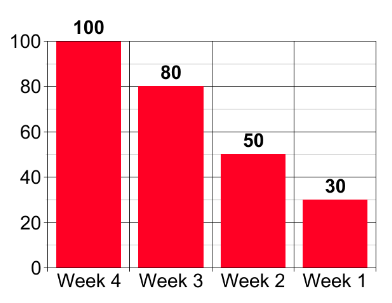Tapering for runners is the process of reducing running load in the weeks leading up to a running event. The aim of the running taper is to maximise your peak fitness by allowing your body to recovery from regular training. The literature on tapering for runners shows that a good taper will improve performance on race day by 2-6%. This may not seem like much, but it can be the difference between a 3:04 marathon and a 2:59 marathon.

Most runners understand the basic principle of the taper “Less is more”. However, many runners struggle to find a tapering method that works for them.
We all know runners who go from running 80km per week at 4 weeks out from a race, to running 20km a week from 3 weeks out onwards. This drop in training is excessive and often leads to poor performance. On the other end of the spectrum, many runners will continue hard workouts up until race week, leaving them with dead and tired legs on race day.
So, how do we construct a good taper? We have used information from elite coaches and the literature to create a standard taper. Once you have tried this method, it is easy to modify for each person individually.
Remember, tapering is not just about reducing running volume! Sleep, nutrition and mental preparation are just as important during the lead up to a race. We will talk more about these later on.
Tapering Program for Runners

4 Weeks Out
4 weeks from race day you will ideally have reached your peak weekly milage. For most endurance runners, this will also be the week of your longest long run.
3 Weeks Out
Reduce your total running volume to 80-90% of your week 4 peak milage. Keep the intensity of your running workouts the same.
2 Weeks Out
Reduce your running volume to 50-70% of your week 4 peak milage. Keep the intensity of your running workouts the same. Do your final hard running workout 10 days out from race day. This is because it takes about 10 days for your body to fully recover from a hard workout.
1 week out (Race Week)
This is race week! Your total running volume can be anywhere from 5-30% of your week 4 peak milage. Do not do any hard workouts during this week. Most running you do this week will not provide any physiological benefit but it will help you mentally prepare for race day.
Many runners like to do a short, 3-5km easy run the day before a race for mental preparation. You can add 3-5 short 10-15 second strides (quick bursts at 3km-1km pace). This will help give you that feeling of “pop” in your legs on race day (“Pop” is the feeling that your legs are working like springs rather than dead weights, it’s due to optimum muscle tension).
Sleep and Tapering
Sleep is always important for runners (see here). Sleep is the most important recovery tool you have. During the tapering period it is important to maximise the duration and quality of your sleep to enhance recovery. Athletes should aim for 8-9 hours each night.
Nutrition and Tapering
During the taper period, your nutrition should not change dramatically. Now is not the time to start “eating right”. That time was about 3 months ago. However, many runners will start focussing on “carb loading”. That is, increasing carbohydrate intake before a race.
Carbohydrate loading
During race week, eat like you normally would. Try to choose more carb based meals 4-5 days out from race day. However, don’t suddenly start eating massive bowls of pasta each night if you don’t normally eat pasta.
You do not need to eat a large carbohydrate meal the night before a race. As you are eating like normal and not running as much, your carbohydrate stores will be optimised. If you eat a large bowl of pasta the night before a race, you will likely feel bloated and heavy the next day. You may find you need to go to the toilet more often as well due to the excessive carbohydrate intake.
Mental Preparation and Tapering
In the weeks leading up to the race, it’s important to prepare mentally. This involves reducing as many unnecessary stresses as possible. You may not be able to control work/home stress, but you can control other forms of stress. Ensure you have organised and packed your running kit many days before the race. Also, arrive at your race destination at least 1-2 days before to avoid rushing at the last minute. (Confession: I once missed my alarm, woke up 10 minutes before my marathon started, ran to the start line whilst eating a banana and started the race 15 minutes late just before they closed the start line, this was undue stress!)
Visualisation
Visualising yourself running your race is a excellent way at mentally preparing. This doesn’t mean just imagining yourself at the finish line with a medal around your neck. It means meticulously and repeatedly visualising every aspect of the race and every problem that may arise. Visualise what it will feel like when your legs don’t want to go any further, and then visualise yourself summoning the will to push through this pain.
Final Note!
Record how you feel physically and mentally during each week of the taper. This will help you evaluate if this tapering method is right for you. Adapt the taper for your next race based on your own evaluation.
Good luck and taper well my friends!